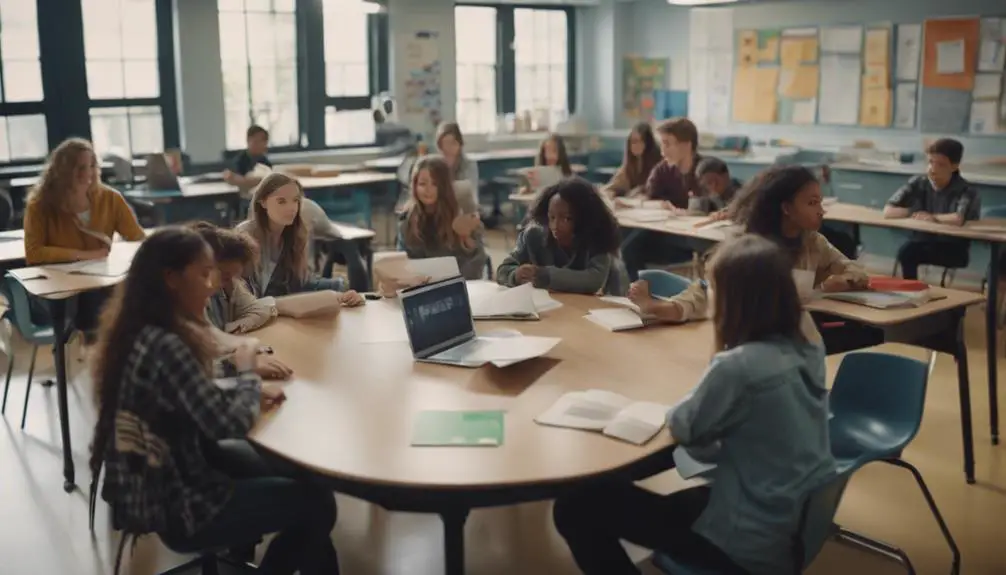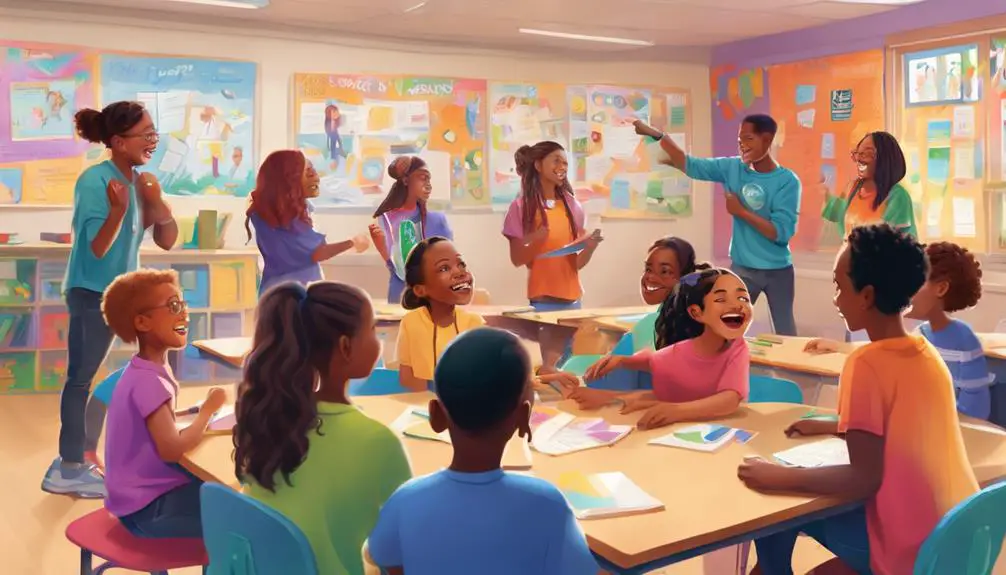Imagine yourself in a classroom where adaptable grouping strategies are in action, offering a dynamic way to personalize instruction. Educators, like myself, have found that these strategies enhance student engagement and learning.
Techniques such as Think-Pair-Share, Jigsaw, and Station Teaching are utilized to cater to a variety of learner needs. Through cooperative methods, teachers can create a more interactive and supportive learning environment, fostering deeper understanding and enhancing critical thinking skills.
These strategies truly revolutionize the classroom experience for both students and teachers.
Flexible Grouping Strategies in the Classroom
Think-Pair-Share
When teaching, I frequently use the Think-Pair-Share technique to boost student engagement and teamwork. This method encourages students to first gather their own thoughts, then team up with a classmate to discuss their ideas, before presenting them to the larger group. It’s a powerful approach to encourage active participation and enhance comprehension among students.
In my classroom, I’ve noticed that applying the Think-Pair-Share strategy helps create a sense of community and mutual support. Students have the chance to ponder a question or topic individually, leading to more thoughtful responses during the sharing phase. This approach also fosters peer learning and communication skills, which are crucial for their academic and personal development.
Moreover, this technique can be adapted to various group settings such as a debate club, think tank, or study buddy system. By incorporating tools like mind maps to visually organize ideas, students can enhance their critical thinking skills and engage more deeply with the content. Overall, the Think-Pair-Share strategy is a valuable asset in establishing a dynamic and collaborative learning environment.
Jigsaw
Assign different topics or sections of a text to each member of a home group. Students become “experts” and then teach their section to the others in their group.
In my classroom, I’ve discovered that implementing the Jigsaw technique involves assigning different topics or sections of a text to each member of a home group. This allows students to become specialists who then teach their section to others in the group. This method encourages collaborative learning and deeper understanding among students.
Here are some key aspects of the Jigsaw technique:
- Expert Exchange: Students become proficient in their assigned section and share knowledge with their group members, promoting a peer-to-peer teaching and learning environment.
- Text Section: Breaking down the text into sections ensures that each student is accountable for mastering a specific part, which they can then share with their peers through teaching.
- Task Rotation: By rotating roles within the small group, students engage in different aspects of the material, enhancing their overall comprehension.
- Discussion Roles: Assigning specific roles within the group discussions encourages active participation and ensures that all students contribute meaningfully.
Station Teaching
Set up different stations around the room with various tasks or activities. Students rotate through the stations in small groups.
Setting up different stations around the classroom with a variety of tasks or activities creates an engaging and dynamic learning environment where students can rotate through diverse learning experiences in small groups. Task rotation and group collaboration play vital roles in station teaching, fostering interactive learning and peer feedback.
The interactive activities at each station encourage student participation by offering hands-on tasks tailored to different learning styles. Collaborative tasks at the stations present a range of learning opportunities, promoting teamwork and shared knowledge among students. In small groups, students can collaborate to complete tasks, exchange ideas, and support each other’s learning journey.
Station teaching enhances academic growth and cultivates essential social skills, making it a valuable strategy for establishing a student-centered classroom that emphasizes both individual development and collective success.
Literature Circles
Similar to book clubs, students form groups based on a book they are reading and take on different roles, like summarizer or vocabulary enricher.
Engaging in Literature Circles offers students a chance to dive into a book, taking on various roles like summarizer or vocabulary enricher to enhance their understanding and promote collaborative learning. Dedicated to supporting student growth, I believe Literature Circles provides a unique way for students to connect with texts meaningfully. Here are the benefits of Literature Circles for students:
- Spotlight on Summarizing: As summarizers, students practice extracting main ideas and key points from the text, improving comprehension and the ability to communicate information concisely.
- Lexicon Challenge: The role of vocabulary enricher pushes students to explore and expand their word knowledge, fostering language development and a deeper engagement with the text.
- Character Exploration: Through in-depth conversations about characters, students develop empathy, critical thinking skills, and a better understanding of character motivations and actions.
- Predicting Plot Twists: Encouraging students to predict the plot’s direction encourages active involvement with the text, helping them make connections and anticipate outcomes, enhancing their analytical abilities.
Fishbowl
Incorporating the Aquarium technique in the classroom creates an engaging discussion dynamic. Here, the inner circle actively participates in the topic while the outer circle listens attentively.
This method promotes peer coaching, debate, and a collaborative learning environment where students benefit from diverse perspectives. As students take turns in the inner circle, sharing insights, round-robin, and philosophical inquiry seamlessly blend together. Meanwhile, the outer circle observes and absorbs information, enhancing critical thinking and analysis similar to a critical friends’ mock trial.
Through dialogic exchange and philosophical chairs, students explore varied viewpoints and hone their communication skills. Collaborative inquiry and reflective dialogue thrive as students switch roles, deepening their understanding through active participation. This strategy encourages students to engage in meaningful discussions and develop a deeper appreciation for the subject matter.
Numbered Heads Together
A number is assigned to each member of a team. When a question is asked, groups work together, and the teacher randomly calls a number for the answer.
When a question is asked, each team member is assigned a number, and we collaborate together, awaiting the teacher’s random selection for the answer. This strategy not only fosters teamwork but also ensures active participation from all group members. As someone who values inclusivity and engagement, this method resonates with me for several reasons:
- Brainstorm buddies: Numbered Heads Together encourages students to collectively brainstorm ideas, drawing on the diverse perspectives within the group.
- Collaborative challenges: Working together to solve problems or answer questions helps students leverage each other’s strengths and tackle challenges as a team.
- Team trivia: Participating in trivia questions as a team fosters camaraderie and motivates students to support one another in gaining knowledge.
- Partner debates: This approach can be adapted to include debates where students collaboratively defend their positions, nurturing critical thinking and communication skills.
Carousel Brainstorming
Imagine yourself moving around the classroom, actively contributing ideas to different chart papers during Carousel Brainstorming sessions. This interactive activity encourages collaborative sharing as students engage in team collaborations to explore various topics. As students rotate around the room, they can add their thoughts and perspectives to the chart papers, leading to insightful group reflections and peer discussions. Through group contributions, students deepen their understanding of the topics and enhance their interactive learning experience.
Carousel Brainstorming encourages group participation and collaborative engagement by allowing students to share ideas openly and build upon each other’s contributions. This strategy promotes teamwork, sparks creativity, and fosters a sense of community within the classroom. By actively participating in Carousel Brainstorming, students develop essential communication and teamwork skills while engaging in topic exploration in a dynamic and interactive manner.
Concept Mapping
Concept maps are collaborative visual tools used in classrooms to connect ideas and establish relationships between concepts. Through visual brainstorming, groups can capture thoughts and concepts in a structured manner, enhancing their understanding of the topic.
Working together on concept maps promotes teamwork and communication skills as members collaborate to create a coherent visual representation. These maps help students see how different concepts are interconnected, improving their comprehension and retention of information.
Visualizing concepts in this way creates an engaging and interactive learning experience, catering to diverse learning styles within the group. Constructing concept maps encourages critical thinking and creativity among group members, fostering a deeper understanding of complex topics.
Socratic Seminar
Participating in a Socratic Seminar involves students engaging in a structured discussion focused on a text to deepen their understanding through open-ended questioning and dialogue. This method fosters critical thinking, encourages thorough analysis of the text, and promotes in-depth discussion through inquiry-based learning.
Thought-provoking conversations emerge as participants ask open-ended questions, share viewpoints, and respond to each other’s ideas. The Socratic Seminar format creates a collaborative environment where students actively interact with the material and each other, leading to a more profound comprehension of the topic being discussed.
The benefits of a Socratic Seminar include encouraging critical thinking, enhancing text analysis by exploring its intricacies, fostering meaningful discussions that delve into various interpretations, promoting learning through inquiry by encouraging questions and dialogue and stimulating engaging conversations that prompt participants to think critically and articulate their ideas clearly.
Peer Tutoring
Taking a collaborative approach, students enhance their understanding by alternating between tutoring each other on specific skills or content. Peer coaching and collaborative learning establish a supportive environment where individuals can both teach and learn from one another.
Study buddies and reciprocal teaching promote camaraderie and shared knowledge, fostering academic growth. Learning partners engage in skill exchange, refining their expertise through teaching and learning.
Tutoring circles and knowledge sharing broaden the learning community, allowing for diverse perspectives and approaches to mastering content. Dual mentoring and cooperative education provide mutual support and guidance, nurturing a culture of shared success and continuous learning.
Through these practices, students not only enhance their understanding but also contribute to the academic development of their peers, creating a collaborative and enriching educational experience.
Snowball Discussions
Snowball discussions involve students crumpling up their written thoughts into ‘snowballs’ and passing them to classmates for further discussion. This activity encourages interactive exchanges and engaging conversations among students, fostering collaborative learning.
Each crumpled paper contains a student’s initial response, sparking collaborative exploration. As the ‘snowballs’ circulate in the classroom, ideas are shared, expanded upon, and enriched by each participant’s contributions.
This method promotes teamwork, with students acting as thinking partners, exploring diverse perspectives and insights together.
The progression of a snowball discussion unfolds in several stages: students start by writing down their thoughts and crumpling the paper, then pass the ‘snowball’ to a peer and receive one in return. Next, each student reads the response, adds their thoughts, and engages in discussion.
Finally, reflective responses are shared with the whole group, creating a rich exchange of ideas. Through this collaborative process, students actively participate in a dynamic learning experience that enhances critical thinking skills and teamwork.
Inside-Outside Circles
The outer circle faces inward and vice versa, and then members of each pair off for discussion. Afterward, one circle rotates so everyone has a new partner.
When setting up inner-outer circles in the classroom, participants face each other and then pair up for discussions, fostering dynamic engagement and mutual learning. This strategy offers several benefits for your classroom environment:
- Circle rotations: Rotating circles allow every student to interact with a variety of peers, promoting inclusivity and diverse perspectives throughout the discussions.
- Expert teaching: Encouraging students to take on teaching roles within their pairs empowers them to share their knowledge and skills, enhancing collaborative learning experiences.
- Station activities: Integrating different station activities within the circles caters to diverse learning styles and interests, enhancing the effectiveness and engagement of the discussions.
- Inner listening: Emphasizing active listening skills encourages students to truly understand and empathize with their partner’s perspective before responding, fostering deeper communication and mutual respect.
Implementing inner-outer circles nurtures collaboration, communication, and critical thinking skills among students, creating an interactive and enriching learning environment that supports their holistic development.
Pairs Check
Pairs work on assignments together, checking each other’s work, and then discussing their answers with another pair.
Implementing the Pairs Check strategy in the classroom fosters collaborative learning and enhances students’ understanding through mutual feedback and discussion with their peers. When pairs work together on assignments, they not only check for errors but also discuss the reasoning behind each other’s answers. This collaborative process creates a supportive environment where peer feedback is valued, and partner reflections deepen comprehension.
The essence of Pairs Check lies in the collaborative discussions between partners. As students collaborate, they engage in meaningful conversations about the task, exploring various perspectives and approaches. Through this interaction, individuals not only reinforce their understanding but also gain insights from their peers.
Furthermore, Pairs Check promotes team analysis when pairs share and discuss their answers with another pair. This exchange of ideas leads to a more robust discussion of thoughts and strategies, enriching the overall learning experience. By incorporating this strategy into classroom activities, educators can cultivate a culture of cooperative learning and shared growth among students.
Speed Dating
In the realm of innovative classroom engagement techniques, an interactive approach called Speed Dating has emerged. This strategy involves students lining up in pairs to briefly discuss a question before rotating to a new partner, fostering active participation and enhancing communication skills in a lively manner.
Alongside Speed Dating, another engaging method is Debate Duos, where students are paired up for quick debates on various topics to hone their critical thinking and persuasive speaking abilities. Question Swap is also effective, encouraging students to generate thought-provoking questions for collaborative discussions with their partners, creating a conducive learning environment.
Incorporating Partner Puzzles into the mix can further enhance teamwork and cooperation among students. This involves assigning tasks or problems that necessitate joint effort to solve, promoting mutual understanding and camaraderie.
Reflective Rounds after each rotation allow students to ponder and share insights gained from their previous partner, reinforcing the learning process and fostering self-awareness. These methods collectively enrich the educational experience by promoting active engagement and skill development in a dynamic setting.
Learning Partners
Assign students a partner with complementary skills or knowledge so they can support each other’s learning.
Pairing students with different skills or knowledge levels enhances their learning journey by promoting collaboration and mutual support.
Through working together on projects, engaging in group discussions, and solving problems as a team, students can delve into in-depth conversations, share diverse viewpoints, and enhance their critical thinking abilities.
Collaborating with a learning partner also offers the opportunity for peer reflection, which can lead to personal growth and skill development.
By exchanging ideas, acknowledging each other’s strengths and areas for improvement, and providing helpful feedback, students can deepen their understanding of the material and sharpen their problem-solving skills.
Cooperative learning with a partner empowers students to take charge of their own learning while considering various perspectives. This approach not only reinforces their grasp of the subject matter but also cultivates empathy, effective communication, and teamwork. By leveraging one another’s strengths and supporting areas that need improvement, students can achieve a more profound comprehension and mastery of the material in the classroom.
Group Investigations
Engaging in group investigations enables students to explore a topic from various perspectives, with each member taking on a different aspect and then teaching the group. This approach encourages collaborative learning and a deeper understanding of the subject through discussions and sharing of knowledge.
Here are four key benefits of incorporating group investigations in the classroom:
- Investigative Dialogues: Group investigations spark active discussions among students, prompting them to ask questions, exchange insights, and explore different angles of the topic.
- Pair Exploration: Working in pairs within the group allows students to leverage each other’s strengths and skills to delve deeper into specific aspects of the topic, enhancing their overall learning experience.
- Perspective Sharing: Group investigations facilitate the sharing of unique viewpoints, enriching the collective understanding of the topic and fostering diversity of thought.
- Topic Dissection: By assigning different aspects of the topic to each group member, students engage in thorough topic analysis, gaining a comprehensive view of the subject while developing specialized knowledge in their respective areas.
Role Play
In our classroom, students often take on different roles in scenarios to better understand concepts and historical events. This role reversal helps them gain empathy and critical thinking skills by viewing situations from various perspectives. Through analyzing scenarios, students sharpen their problem-solving abilities while considering diverse viewpoints.
Historical reenactments make the past come alive, transforming history into more than just words on a page. Immersing themselves in key moments gives students a deep appreciation for the challenges and victories of those who lived before them. This hands-on experience creates a connection to history that textbooks alone can’t provide.
Exploring concepts through role play goes beyond traditional teaching methods, making learning engaging and memorable. As students embody different roles, they develop a profound understanding of the subject matter, internalizing lessons in a way that lectures can’t accomplish. Role play in our classroom isn’t just an activity; it’s a powerful tool for nurturing compassionate and knowledgeable individuals prepared to make a positive impact in the world.
Conclusion
In the realm of education, adaptable grouping strategies serve as magical instruments that transform dull lessons into captivating adventures. Integrating techniques like Think-Pair-Share, Jigsaw, and Literature Circles allows educators to cultivate dynamic learning environments where students can truly thrive.
These strategies empower students to take charge of their own learning journey, unlocking their full potential while fostering collaboration among peers. The possibilities that arise from such approaches are boundless, and the impact they’ve is truly extraordinary.
Let’s wave our educational wands and witness the enchanting transformation unfold!
















